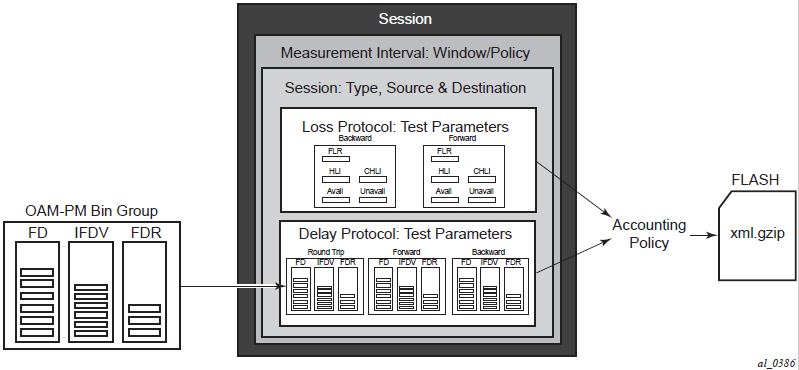OAM-PM provides an architecture for gathering and computing key performance indicators (KPIs) using standard protocols and a robust collection model. The architecture comprises the following foundational components:
session
The session is the overall collection of different tests, test parameters, measurement intervals, and mappings to configured storage models. It is the overall container that defines the attributes of the session.
standard PM packets
Standard PM packets are the protocols defined by various standards bodies which contains the necessary fields to collect statistical data for the performance attribute they represent. OAM-PM leverages single-ended protocols. Single-ended protocols typically follow a message response model, message sent by a launch point, response updated and reflected by a responder.
measurement intervals (MI)
MI are time-based non-overlapping windows that capture all results that are received in that window of time.
data structures
Data structures are the unique counters and measurement results that represent the specific protocol.
bin group
Bin groups are ranges in microseconds that count the results that fit into the range.
The following figure shows the hierarchy of the architecture. This diagram is only meant to show the relationship between the components. It is not meant to depict all details of the required parameters.

OAM-PM configurations are not dynamic environments. All aspects of the architecture must be carefully considered before configuring the various architectural components, making external references to other related components, or activating the OAM-PM architecture. No modifications are allowed to any components that are active or have any active sub-components. Any function being referenced by an active OAM-PM function or test cannot be modified or shut down. For example, to change any configuration element of a session, all active tests must be in a shutdown state. To change any bin group configuration (described later in this section) all sessions that reference the bin group must have every test shutdown. The description parameter is the only exception to this rule.
Session source and destination configuration parameters are not validated by the test that makes use of that information. When the test is activated with a no shutdown command, the test engine will attempt to send the test packets even if the session source and destination information does not accurately represent the entity that must exist to successfully transmit packets. If the entity does not exist, the transmit count for the test will be zero.
OAM-PM is not a hitless operation. If a high availability event occurs that causes the backup CPM to become the active CPM, or when ISSU functions are performed, the test data will not be correctly reported. There is no synchronization of state between the active and the backup control modules. All OAM-PM statistics stored in volatile memory will be lost. When the reload or high availability event is completed and all services are operational then the OAM-PM functions will commence.
It is possible that during times of network convergence, high CPU utilizations, or contention for resources, OAM-PM may not be able to detect changes to an egress connection or allocate the necessary resources to perform its tasks.